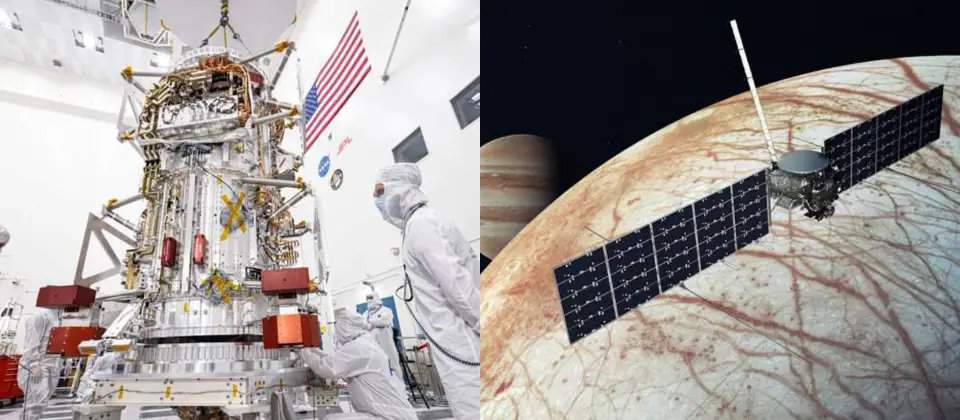Europa became one of the most fascinating celestial bodies in the solar system. After Galileo Galilei discovered Europa on January 8, 1610, Astronomers developed a special interest to learn more about this unique moon that is locked in Jupiter’s orbit. NASA had already studied Europa on several deep space missions. But the agency still wants to learn more about the icy moon.
In fact, NASA is already working on a futuristic spacecraft to continue its research on Europa. What is this new mission all about? What inspired NASA to make plans for future space missions to Europa? Is the Europa Clipper Mission the first giant step towards colonizing the Icy Moon? Let’s find out from this article.
How NASA is Building a Futuristic Spacecraft to Visit Europa?
NASA is a Space Agency known for its innovations and for creating several histories in space exploration. Despite the great milestone it has attained in the past, NASA has decided to build a spacecraft to explore Europa. This spacecraft is named Europa Clipper which will be launched in October 2024 upon completion.
The spacecraft will fly for five and half years to arrive at Jupiter in 2030. Upon arriving at Gas Giant Planet, it will begin its exploration by following the elliptical orbit of Jupiter to study Europa.
But Why will Europa Clipper not be injected into Europa’s Orbit directly?
During this mission, Europa Clipper will not orbit the icy moon directly. Due to the adverse effects of radiation that is created by Jupiter’s Magnetosphere in Europa’s orbit, our sophisticated Spacecraft may not survive in Europa’s Orbit. To avoid any interference with this mission, NASA will inject the spacecraft into an elliptical orbit around Jupiter. Once Europa’s Clipper has taken its position around Jupiter, it will proceed to make 44 close flybys to Europa.
So why is Europa Clipper a unique spacecraft?
Unlike NASA’s past spacecraft designs, the Europa Clipper will be the largest spacecraft ever built by NASA for a planetary space mission. The gigantic Spacecraft will be powered by large solar arrays accompanied by radar antennas to ensure that the mission becomes successful.
The massive solar arrays will gather enough solar light to energize the spacecraft throughout the mission. Keep in mind that Jupiter is located in a region that receives less sunlight than Earth. So if Europa Clipper will meet the mission requirements at such a distance, it surely needs sophisticated solar arrays to attract more power from the sun.
NASA is building the spacecraft to be about 16 feet (5 meters) tall. When the massive solar arrays are attached to the spacecraft, it will cover over 100 feet (30.5 meters). The spacecraft will also be built with a dry mass of 7,145 pounds (3,241 kg).
Dry mass is the weight of the spacecraft with no propellant on its tanks. Scientists estimate the launch mass of the Europa Clipper to be 13,371 pounds (6,065kg). NASA scientists and engineers are currently building the Europa Clipper spacecraft at NASA’s Jet Propulsion Laboratory located in California, USA.
When the design and construction of this futuristic spacecraft are completed, it will be launched atop SpaceX Falcon 9 rocket on 10 October 2024.
The Europa Clipper Mission will be used to support ESAs Jupiter Icy Moons Explorer which will be launched in 2023. We all should wish NASA great success as they begin to work on this project.
What is NASA planning to achieve from this mission?
NASA does not commence on a space mission without a goal. So before the design of Europa Clipper began, NASA already had its plans for this future mission. The space agency wants to send the Spacecraft to Europa to continue the research from where the Galileo spacecraft stopped.
Keep in mind that the Galileo spacecraft spent about eight years in Jupiter’s orbit. During this mission, the Spacecraft discovered that the subsurface ocean lies beneath Europa’s ice crust. NASA plans to send the Europa Clipper to get more detailed research about Europa and update our knowledge about the icy moon of Jupiter.
Is the Europa Clipper Mission the first giant step towards colonizing the Icy Moon?
After the Galileo spacecraft indicates that a subsurface ocean is lying under Europa, Scientists began to wonder if some forms of microbial life exist on the icy moon. Since Europa Clipper will continue Galileo’s research on Europa, Scientists will likely learn something new from this mission.
The new dataset provided by the Europa Clipper will help Scientists in preparing for the first lander mission on the icy moon’s surface. Since Jupiter’s radiation is high on Europa’s Orbit, Scientists need to figure out how to handle the adverse effects of this radiation to avoid experiencing failure while visiting Europa’s Orbit in the future.
This implies that we must be highly sophisticated in building space Technologies to attain this milestone. But no matter what happens, humans may likely send a lander and a Rover to Europa’s surface someday in the future. The data which will be provided by Europa Clipper Spacecraft will surely move us closer to actualizing this future of impossibilities.
Conclusion
NASA is already preparing for Europa Clipper Deep Space Mission. This is why the space agency is using its best Scientists and engineers to build the spacecraft. If everything falls in its place, the Europa Clipper should be in Jupiter’s orbit by 2030.
From this point, we shall begin to learn something new about the Icy Moon of Jupiter. Do you think that this Europa Clipper Mission will help us discover the first microbial life outside Earth?





